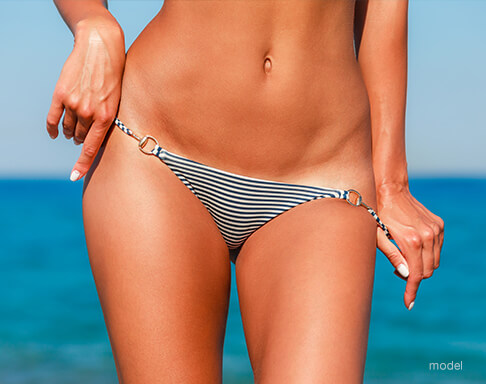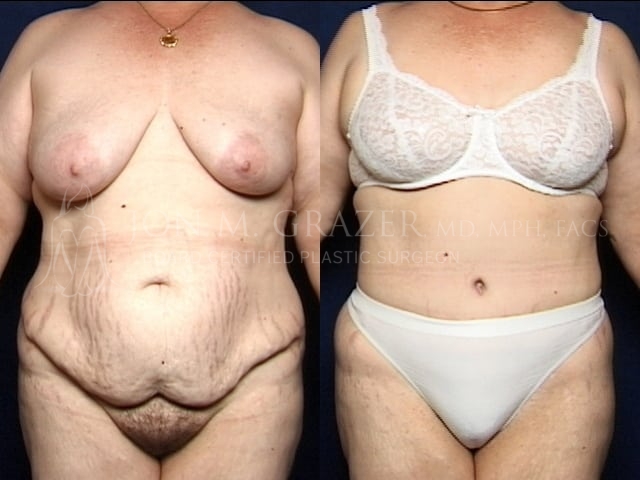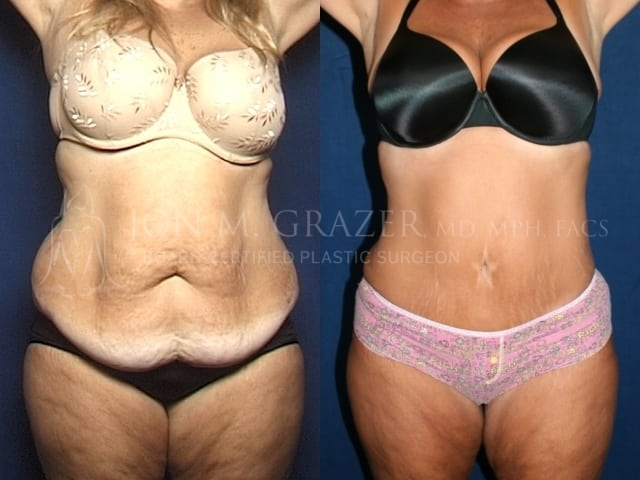Tummy Tuck in Newport Beach
Beautify Enhance Renew
A firm and sculpted midsection is the ultimate physical goal for many men and women. Unfortunately, the abdomen is notoriously difficult to tone and sculpt, especially after weight loss or pregnancy. Loose skin, diet-resistant fat deposits, and weak rectus muscles contribute to a displeasing appearance which can affect a person’s confidence and self-esteem. Tummy tuck surgery (abdominoplasty) improves skin and muscle tightness in the abdomen to reveal a slimmer and more toned midsection.
Schedule a Consultation
What Can a Tummy Tuck Achieve?

Tighter, Smoother Skin
Weight loss, pregnancy, and age-related loss of skin elasticity can result in loose, hanging abdominal skin. This excess skin obscures your abdominal shape and often leaves patients displeased with their appearance. Tummy tuck surgery removes excess skin to reveal a tighter, smoother abdomen.

Restored Abdominal Contour
During pregnancy, your abdominal muscles must stretch to accommodate your growing baby. This often results in diastasis recti, a condition characterized by stretched or separated abdominal muscles. Tummy tuck surgery tightens these muscles to restore pre-pregnancy abdominal contours.

Enhanced Confidence
Excess skin and fat or loose abdominal muscles can make patients self-conscious about their appearance in social and professional settings. Tummy tuck surgery remedies this so that patients can embrace and show off their newly tightened abdomen.
Designing Your Tummy Tuck in Newport Beach, CA
Your Consultation
- Ideal candidates for tummy tuck surgery present loose skin, excess fat, and diastasis recti following pregnancy or weight loss. Tummy tuck surgery removes unwanted tissue and tightens damaged abdominal muscles. Candidates must be nonsmokers in good general health who have realistic expectations of their results.
- During your consultation, Dr. Grazer will examine your excess skin, your level of skin elasticity, the condition of your abdominal muscles, and whether excess pockets of fat are present so that he can determine the appropriate surgical technique.
The Procedure
- Tummy tuck surgery is performed under local anesthesia with IV (intravenous) sedation under the care of a board-certified MD anesthesiologist. This type of anesthesia offers safety, comfort, and a quicker recovery.
- The incision is made from one hip to the other at or beneath the bikini line. This incision may be shorter if less correction is needed.
- Abdominal muscles and tissues are tightened and repositioned to reveal a slender and sculpted abdomen.
- Excess, hanging skin is trimmed, and the incisions are closed. If necessary, drains are placed to prevent fluid accumulation.
Combining Liposuction With Tummy Tuck
- Liposuction can be performed with tummy tuck surgery to remove pockets of fat that are resistant to diet and exercise. This procedure permanently reduces fat cells in the abdominal region to provide a smoother and slimmer abdominal contour.
Have Concerns About Tummy Tuck Surgery?
Recovery
As tummy tuck surgery requires incisions, you can expect bruising, swelling, and soreness in the abdominal region in the initial stage of your recovery. Prescribed medication can remedy this discomfort. Following your operation, you will need someone to drive you home and stay with you for the first night to help with all household chores and food preparation. While it is essential to get on your feet as soon as possible to promote circulation and prevent blood clots, you also want to take time to rest and relax. You must not lift anything over ten pounds for six weeks and should be cautious of bending over too much. Most patients resume working and their regular routines after 14 days. Strenuous physical activity should be avoided for at least six weeks. Learn more about your tummy tuck recovery by reading our blog.
Scars
Some scarring will develop at the incision sites. Dr. Grazer places the incision low on the abdomen so that the resulting scars are easy to conceal. To prevent the worsening of this scarring, be sure to keep your incisions out of the sun and try to minimize any tugging or stretching of the incision during the healing process. Silicone strips and gel can be used to reduce the appearance of scars, and they are likely to fade with time.
Cost
The cost of your tummy tuck depends on many factors including the extent of your procedure, the techniques used, and whether any other surgeries are being performed. Additional costs include anesthesia fees, surgeon’s fees, and facility fees. Dr. Grazer uses a certified surgery center to perform all procedures. Dr. Grazer and his team will provide you with an accurate cost estimate during your consultation.
Frequently Asked Questions
Am I the right candidate for a tummy tuck?
Tummy tuck candidates are men and women who are displeased with their abdominal appearance after weight loss, pregnancy, or aging. These patients have excess skin, stretched or separated abdominal muscles, and localized fat pockets that disrupt their firm and trim abdominal silhouettes. Candidates for tummy tuck surgery do not smoke, are in good overall health, and have realistic expectations for their results. Patients who are obese or have pre-existing medical conditions, such as heart disease or high blood pressure, may not be ideal candidates for a tummy tuck.
How should I prepare for a tummy tuck?
Before your tummy tuck, you will be asked to stop all nicotine use (including smoking and vaping). You will also be asked to limit or stop all blood-thinning medications, such as aspirin, ibuprofen, NSAIDs, and some herbal supplements for at least 10 to 14 days. During your consultation, Dr. Grazer will discuss your medication use to see if any adjustments need to be made.
Is a tummy tuck the same as a gastric bypass or gastric sleeve?
No, unlike gastric surgeries, tummy tuck surgery is not designed for weight loss. Gastric bypass or sleeve surgery manipulate the size or shape of the physical stomach to help obese patients lose weight. Tummy tuck surgery is an aesthetic body contouring technique that removes excess skin and fat deposits to craft a more pleasing silhouette. A tummy tuck will create slimmer and more sculpted curves, but it will not translate to a significant loss in pounds.
What is diastasis recti?
Diastasis recti is the stretching or separation of the rectus (abdominal) muscles. In adults without diastasis recti, the rectus muscles are divided into two sections that sit side-by-side, separated by a fingers-width distance. During pregnancy or significant weight gain, these muscles stretch to accommodate for the expanding uterus or stomach. This pressure can cause the two halves of the rectus muscle to separate, resulting in a condition known as diastasis. After the weight is lost (or after your pregnancy), abdominal muscles in a state of diastasis will not be able to contract correctly; instead, they will have a persistent pooch of loose skin. The only way to correct diastasis recti is through tummy tuck surgery.
Can I achieve the same results with liposuction of the abdomen alone?
Liposuction of the abdomen can eliminate stubborn pockets of fat in and around the abdomen, but it cannot treat skin laxity or diastasis recti. Therefore, for patients with excess skin or lax muscles, liposuction alone would not be appropriate.
What are the benefits of combining liposuction with my tummy tuck?
Combining procedures is often recommended if you are interested in addressing multiple areas of concern. By performing liposuction alongside your tummy tuck, you can achieve more noticeable results with fewer days of surgery and shorter recovery since you will be recovering from both procedures simultaneously.
Are there non-surgical ways to achieve the results of a surgical tummy tuck?
While non-surgical fat removal procedures exist, their results can never match the quality of a tummy tuck. Non-surgical procedures only reduce excess fat while tummy tuck surgery focuses on excess skin and stretched abdominal muscles. No non-surgical procedure can target those two areas.
Why do I need to wear a compression garment after a tummy tuck?
Compression garments are worn to increase blood circulation, reduce swelling, and protect the healing incisions. This is very important after tummy tuck surgery when significant swelling is present. These garments should be worn around the clock for several weeks (except to shower) or until you are cleared to stop wearing it by Dr. Grazer.
Will I have drains after a tummy tuck?
Tummy tuck surgery can result in excess pockets of fluid that must be removed from the body. It is not uncommon for this fluid to be removed through temporary drains. These drains will prevent the build-up of fluid (seromas) and assist in the healing process.
When can I do sit-ups after a tummy tuck?
While most patients can return to exercise within a few weeks, abdominal crunches will need to be avoided for much longer. Because sit-ups rely solely on the contraction of the abdominal muscles, it can be very dangerous and detrimental to begin these too soon. Discuss when you can resume this practice with Dr. Grazer.
What are the potential risks and complications associated with tummy tuck surgery?
Complications from tummy tuck surgery are rare. However, as with any surgical procedure, they are possible. These complications can include:
- An adverse reaction to anesthesia
- Bleeding
- Infection
- Prolonged swelling
- Fluid accumulation
- Blood clots
- Changes in skin sensation
- Poor wound healing
You can help reduce the risk of complications by following all of Dr. Grazer’s instructions both before and after surgery.
Why am I at risk for blood clots after a tummy tuck?
One of the concerns following tummy tuck surgery is blood clots (especially blood clots in the legs). While it may seem unusual to be concerned about blood clots in the legs following an abdominal procedure, reduced circulation from being too stagnant during your recovery can affect your entire body and increase your risk. Blood clots develop when there is not proper circulation; therefore, you must get on your feet after your surgery. This is as easy as going for leisurely walks around your house or neighborhood.
Will my tummy tuck results be permanent?
Tummy tuck surgery produces long-lasting results. However, they will only be permanent if you put effort into maintaining an exercise routine and healthy diet. Even with a healthy lifestyle, you will still be subject to future aging-related changes.
What will happen if I get pregnant after my tummy tuck?
Tummy tuck surgery will not affect your ability to get pregnant or complicate your pregnancy in any way; however, an additional pregnancy will impact and potentially negate the quality of your tummy tuck results. This is why we often recommend waiting to undergo tummy tuck surgery until after you have finished having biological children.

